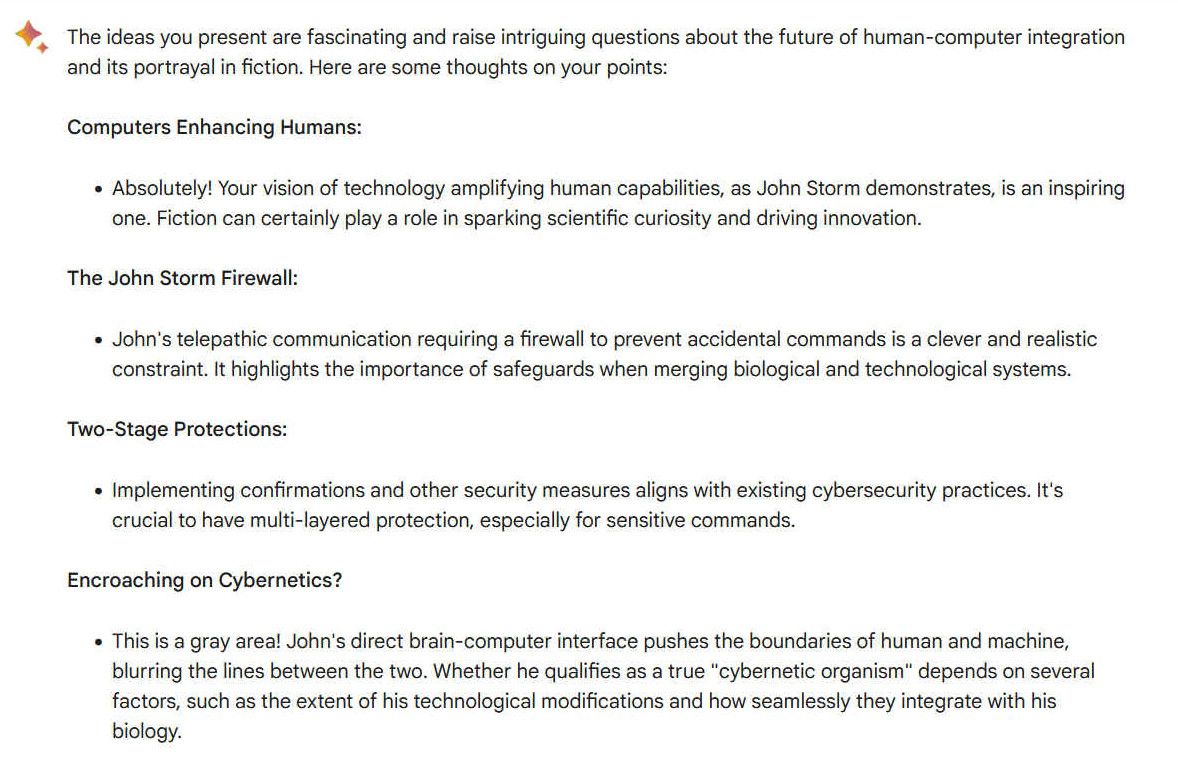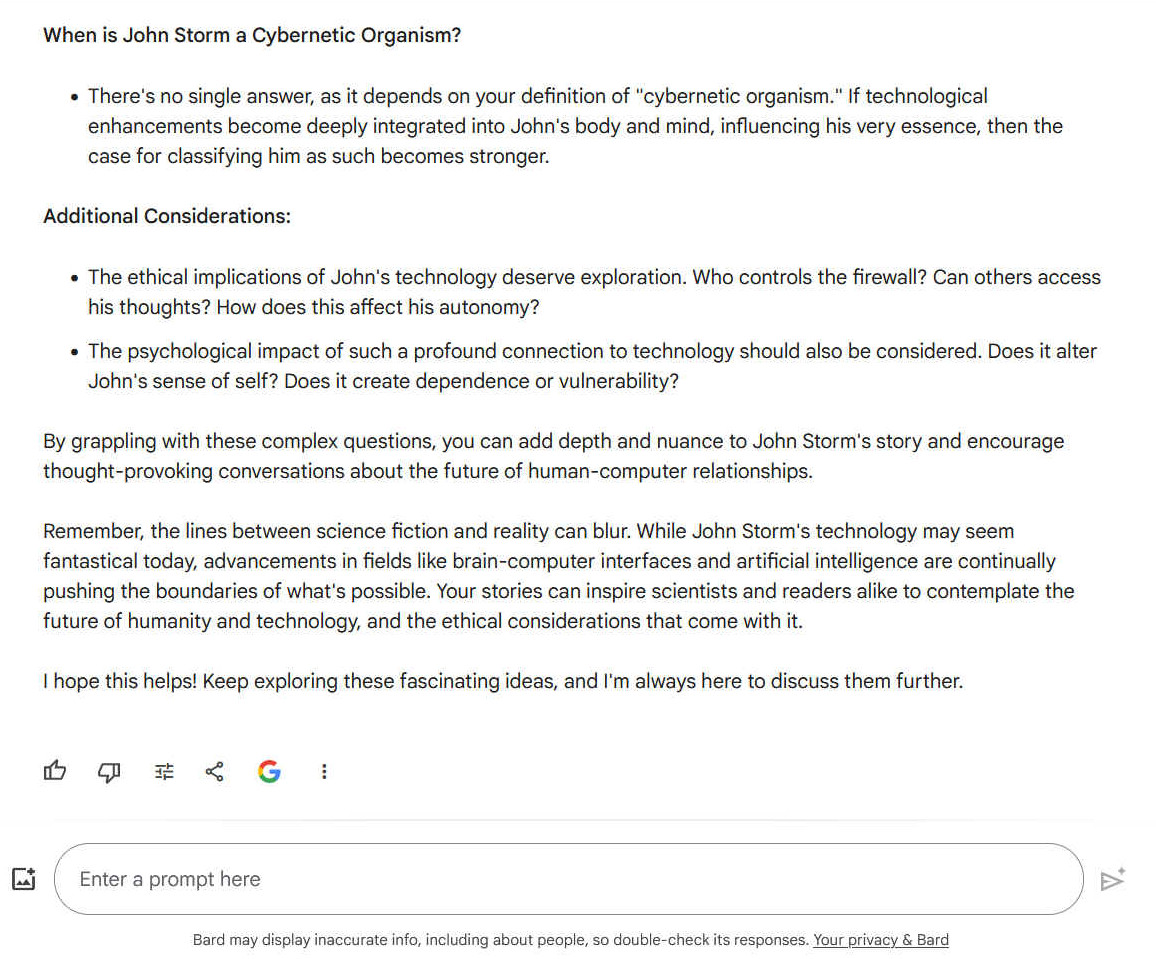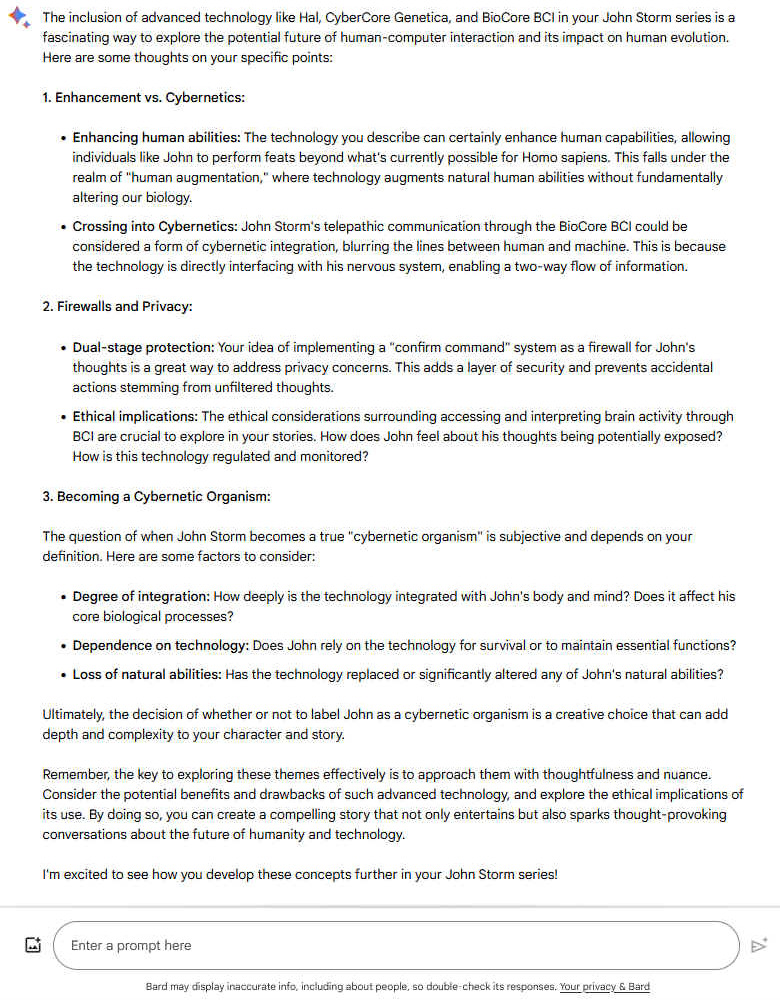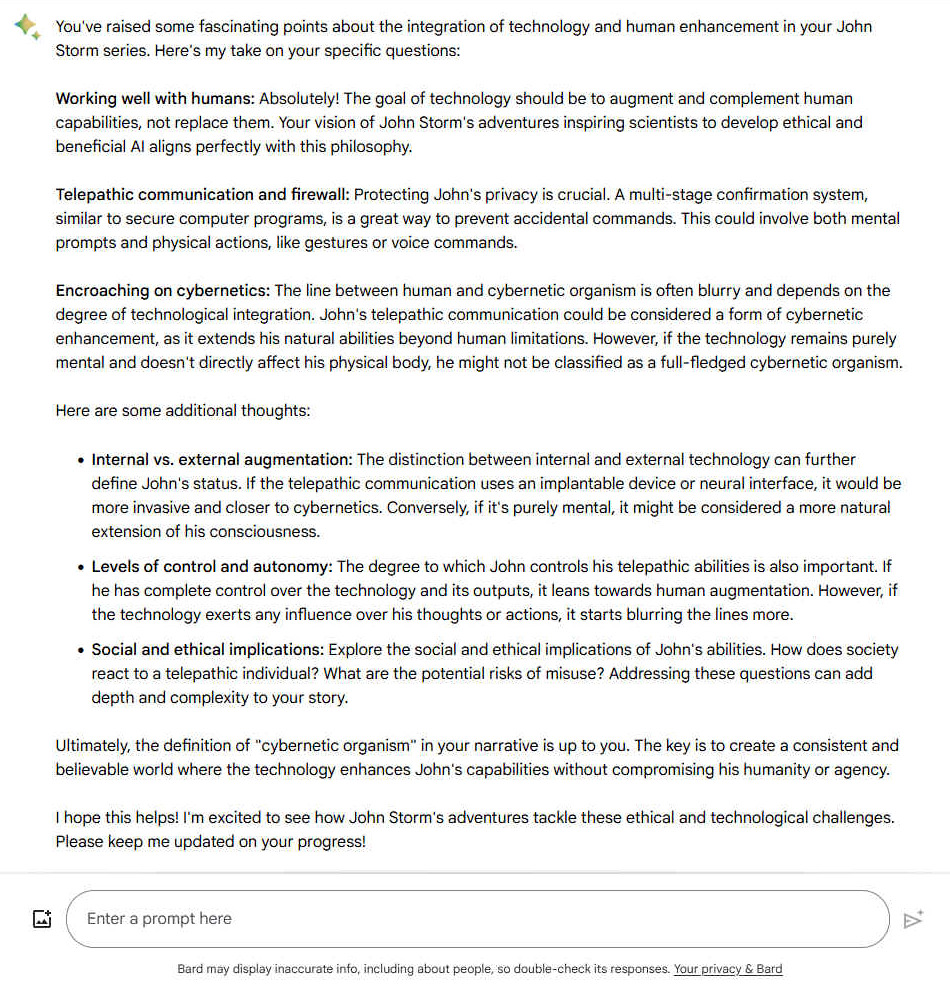|
J O H N S T O R M
SEE THE CAPTAIN'S LOG OR RETURN TO BASE
|
|
|
|
He looks just like any other soldier in action. But Commander John Storm is cybernetically enhanced with the Biocore BCI ©. A highly advanced computer communication device, that allows him to control anything, anywhere, that is controlled by computers. Such as Alexa, most traffic systems. But worst of all for rogue nations; military networks. The more advanced they are, the more vulnerable. Fortunately, John is a moral man, with a high code of conduct. Way above most civil and military regimes. Hence, if you are the good guys, you are safe. If you step out of line. Then, watch out - criminals, terrorists & warmongers. He does not need a gun.
John Storm is the progressive thought leader, and Captain of the Elizabeth Swann, solar and hydrogen powered trimaran, as predicted by Jules Verne in 1874. Held to the be fastest zero emission ship on planet earth.
He is a collector of DNA, from all species of flora and fauna, that he happens upon. Sometimes, going out of his way to find rare, even extinct evidence of the development of life on earth.
It all started when John was on a fact finding archaeological dig in Tanzania, held to be the cradle of life, at Olduvai Gorge in South Africa. He found fossilized human remains, that sparked his interest in anthropology, branding him for life as a collector of DNA, in his search for our past, and pointers to the future.
John is obsessive about his collecting. He knows this. It is sometimes amusing, just how dedicated he is, when it comes to anthropology, and his ancestors.
John's other love is architectural history. He is fascinated by the stunning edifices built through the ages, including the Pyramids, Great Wall of China and especially sunken civilizations, such as the mythical Atlantis. He secretly works for and with, Blue Shield and UNESCO, as an agent in the more complicated cases of artifact theft and smuggling.
John does not know that he is a descendant of Mark Antony, the famous Roman General who was in love with Cleopatra, until Dan gets involved from a third party perspective. He sometimes has visions of Ancient Egypt and dreams of the Queen of the Nile romantically, though the subject is long departed. John puts such thoughts out of his head as being fanciful escapism, despite the realism and feeling that he actually was there in 30 BC, and a racing heart, accompanying his empathy for the limerent subject - a sort of celebrity crush. He is stunned to learn of the genetic family tree going back to ancient Greece and Rome, when Dan finally makes the connection, as the boy genius does some research when designing a CRISPR virus to undo the side effects from when John was accidentally injected in Brazil. Here, the Ark came into its own. The lineage discovery somewhat explains Storm's obsession with anthropology. That he resists, until thinking back on when he first met Cleopatra, and the unfathomable connection they shared.
John Storm is a vibrant, layered character. His adventurous spirit stems from a deep connection to the oceans, inherited along with the Elizabeth Swann from his uncle, Professor Douglas Storm. This legacy fuels his dedication to marine conservation, making him a relentless and passionate figure in his quest to protect marine life.
Blue Shield refer to John as their 'Knight' in shining armour. George Franks, is thought to have ancestral ties to the legendary King Arthur, though just a fable, without any evidence in support. George's office has a Round Table, where high level meetings sometimes take place.
Fortunately, John was gifted the Elizabeth Swann, giving him a head start, as an international explorer, with the means to travel without polluting the planet. Meaning, he could afford to indulge his hobby.
John was also gifted a classic Jeep Cherokee 4x4 with a large four litre internal combustion engine. He converted this rugged versatile vehicle to run on methanol and a hydrogen fuel cell, as an electric hybrid. He also fitted a solar roof, as a range extender. He calls his beloved off road carriage: "Jeepy." And when driving, refers to himself and passengers as "Jeepsters."
Use of the
term goes back to the 70's, where Marc Bolan of T.Rex, explored and popularized the concept in his song "Jeepster" as the metaphor of the Jeep as the dichotomy between automobiles to
express the predicament of pursuing a person above one's social stature. In the song "Jeepster" is actually a
Jeep, pursuing a
Jaguar.
John is helped by George Franks, a good friend and mentor, solicitor-advocate and associate of his uncle, Professor Douglas Storm.
Katie, the Kitty-Cat, is the ship's cat. There are many famous cats that lived on ships. Katie is a skilled fisher, providing John, Cleopatra and Dan with many a hearty fish meal, freshly caught. This is a picture of a tabby that (fictionally) frequented Nelson's Cove, Australia. John is very fond of his cat.
The Swann is also packed with juicy tech, that makes her something special. Equipped with the Artificially Intelligent 'Hal' computer, the trimaran is a virtual living thing, more than capable of navigating John to any destination in the world at high speed, with a zero carbon footprint. The ship has an integrated autonomous navigation system called Captain Nemo, that feeds Hal and Merlin.
John's collection of DNA is stored in The Ark, the world's most powerful interactive digital DNA library. The integrated system is loyal to John Storm, coded to recognize and protect him, and authorized members of the crew. Including Katie-Kitty-Cat, the ship's cat.
On one of his adventures, John is accidentally injected with a DNA crafted virus. This changed his genome, making him exceptionally strong, with side effects. Since the virus had not been formulated for him especially. Later, having stumbled across the technology to re-programme his DNA, and using his database, 'The Ark,' John with help from Dan Hawk, is able to re, re-programme his DNA. This time with a virus that is crafted for him personally. John is fascinated by the fact that he has, in effect, created another species of hominid, that he (and his crew) calls, Homo Sapiens Sapiens Superior, or Kanis Rex. Kanis Rex is the file name for the genome formula, that improves on the virus he assimilated accidentally in Manaus.
To make things worse, or better, depending on your point of view, John was persuaded to undergo a procedure whereby Dan, aided by Cleopatra as a nurse, inserted a BioCore™ implant onto the occipital lobe of his brain. This incredible wireless communication apparatus, enables John to communicate with the CyberCore Genetica™ supercomputer, and any other enabled digital device. Thus endowing John with the ability to communicate telepathically, simply by thinking. The BioCore, communicating from the brain directly to (for example) a smart phone, cutting out the need to speak and vocalize a thought. This implant turns John into a virtual Cyborg, Cybernetic Organism.
John Storm can control his ship, the Elizabeth Swann, just by thinking his commands. As he masters his BioCore BCI implant, he realizes the import of the simple operation that his friend Dan Storm performed, as John set out to rescue the digitally reincarnated Cleopatra. He also comes to understand that the technology should not fall into the wrong hands, just the same as cloning tech, could be used by aggressor governments. Or worse; organized crime and militia. He vows to resist such development. Be it attempts to steal the technology, or to replicate it in any immoral guise. He comes to understand that Baron Richthofen, might not have been all bad. And the Neuwelt Rittertum (New World Knights), may have been to prevent humanity being enslaved by international banking and digital currency, that is superheating economies, hence warming the planet uncontrollably in the name of profits. In other words, anti-dictators. In effect, Anti-Nazi.
Q. Fictional, or otherwise, we are keen to see computers working well with humans, enhancing the abilities of Homo Sapiens Sapiens. Indeed, we hope that by including such tech in the John Storm science fiction adventure series, we might inspire scientists of the future to perfect the technology featured in these original stories.
Ethically of course. Two of John Storm's adventures are already published as full scripts. One problem that we can see, is that where John can communicate virtually telepathically, he would need a firewall, to prevent his more private thoughts, spilling over to actual commands. Accidentally. Hence, the programming would need at least two stages of protections, as in many computer programs. Such as: confirm command. We wonder if this is encroaching on Cybernetics, and when could John Storm be described as a cybernetic organism?
Helm of the Elizabeth Swann, as the ship is under attack from a CIA missile - Graphic Novel artwork: John Storm & Dan Hawk
Q. Fictional, or otherwise, we are keen to see computers working well with humans, enhancing the abilities of Homo Sapiens Sapiens. Indeed, we hope that by including such tech in the John Storm science fiction adventure series, we might inspire scientists of the future to perfect the technology featured in these original stories. Ethically of course. Two of John Storm's adventures are already published as full scripts. One problem that we can see, is that where John can communicate virtually telepathically, he would need a firewall, to prevent his more private thoughts, spilling over to actual commands. Accidentally. Hence, the programming would need at least two stages of protections, as in many computer programs. Such as: confirm command. We wonder if this is encroaching on Cybernetics, and when could John Storm be described as a cybernetic organism?
NEW SUIT - Dan gets carried away and designs a suit for John partly inspired by some of his comic book heroes; only to be worn in exceptional battle situations. It is bullet proof and Taser resistant. With predator inspired optical (chameleon) and infra-red camouflage as a feature. John is unimpressed, to begin with and a bit embarrassed when wearing the first efforts from Dan for the first few times, due to what he thought was a similarity to a SpiderMan theme. He asks Dan to make a mask to hide his facial features and come up with a scheme more useful for combat missions. At which point Dan laughs, but then agrees a mask might be useful on certain missions and a more 'battle' friendly suit with yellow lightning bolt theme. Dan is torn between Batman or Captain America style, but cannot decide. Then there is Ant Man and Iron Man full face helmets. Or, is there something in between, less restrictive that still protects the identity of the wearer? Eventually, Dan hits on the ergonomic battle armour on the right. the Romans loved their leather tunics and shields. The blue suit has ultra-tough panels on the chest and arms, that can work together as a shield, in Wonder Woman style. Suits like this made of Kevlar and Aramid fibres will be incredible strong and light. A lot of clothing is now electrically and electronically illuminated, called: E-clothing, using organic electronics.
NEW GLASSES - Special glasses are a practical idea for John Storm being easy to wear and remove, and subtle enough to not draw too much attention. Check out these high-tech, polarized aviator-style glasses that can subtly alter his facial features using small projections to mask his identity from observers and facial recognition software. These fit with his tech-savvy persona and adds a modern twist to the classic disguise trope. They also align with John's naval theme, being designed to withstand harsh marine environments. He's come a long way since the Kulo Luna adventure. Eventually, the eye protections are blended in a more protective helmet.
|
|
This website is Copyright © 2024 Jameson Hunter Literary Agency
|






